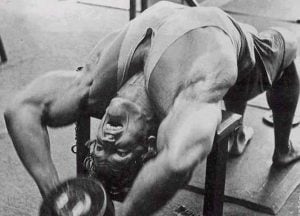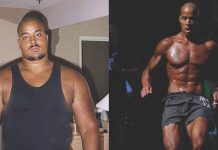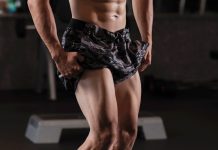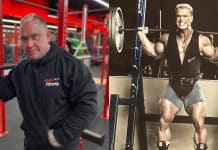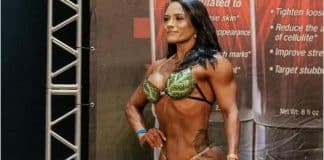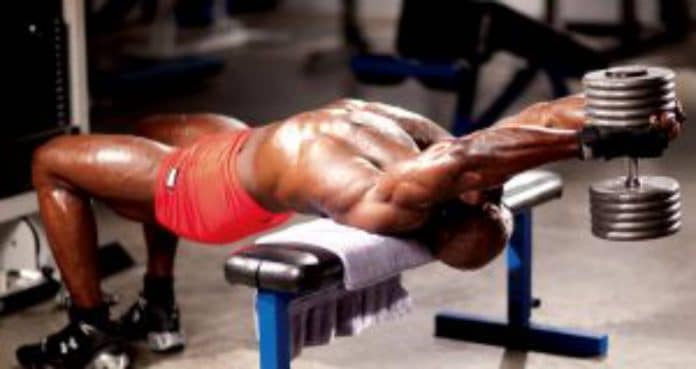
The straight arm pullover simultaneously works your lats and pecs.
The bench press is renowned for building chest muscles, while the lat pulldown effectively targets the back. But imagine a single exercise that promotes muscle growth in both areas simultaneously. Enter the straight arm pullover, a legendary routine favored by bodybuilding icon Arnold Schwarzenegger. Check these out and see alternatives like the cable pullover you can use to spice up your workouts in the article below.
The amazing thing about the straight arm pullover is that it targets the two big muscles of your upper body. Also, did you know that research shows that doing this exercise can improve your cardiopulmonary function (actions of your heart and lungs) (1)? Generally, bodybuilders do this exercise with dumbbells, and keeping your arms straight makes the routine harder and induces more hypertrophy.
Straight arm pullovers offer many more benefits, and we’ll share some of them below. You can also learn the proper way to exercise to maximize muscle gains from this exercise guide.
Techniques and Muscles Worked
The straight arm pullover works on your lats, pecs, abs, and triceps. The primary movers are your lats and pecs. Plus, you can further change which muscle gets more work by switching the position of your elbows. To focus on your lats, slightly flare your elbows while keeping them close to your body.
When doing the straight arm pullover, it’s important to ensure solid body and wrist stability. Below is a step-by-step guide on how to do a straight arm pullover.
- Start by setting up your flat bench and choosing the appropriate dumbbell weight. Start light if you’re a beginner.
- Grab the dumbbell on the end, facing perpendicular to the ground in both hands, then sit at the end of your bench.
- Lie back on the bench facing up, and lift the dumbbell by extending your arms. It should be directly above your chest. This is your starting position.
- Keeping your lower back and pelvis neutral, breathe in and then take your arms back over your head as far as possible. Keep your arms straight but not completely locked, and try to get them to a position alongside your ears.
- Breathe out and, keep your arms straight, return to starting position to complete the rep.
Benefits
Chest and Back Muscle Growth
The straight arm pullover stretches your muscles when your arms are overhead. This provides a massive stimulus for muscle growth in your chest and back. It’s great for enhancing your V-taper since it targets your lats.
Greater Shoulder Mobility
Doing a straight arm pullover involves moving your arms from the shoulders. Your elbow joints remain stationary to keep your arm straight. As a result, your shoulder mobility improves over time.
Versatility
The straight arm pullover is a versatile exercise that can be done with other weights besides the dumbbell, e.g., a small straight barbell. You can also vary the stimuli by changing the incline of your bench. Dumbbells are relatively easier to find since nearly every gym has them.
Better Core Stability
Doing straight arm pullovers involves pulling on your core for stability. As a result, you activate deep core muscles like the traverse abdominis. Training consistently with this exercise will improve core stability and strength.
Avoid Injury
Your back and core muscles help to support your spine through heavy lifts and many other exercises. Straight arm pullovers strengthen these muscles and help you avoid injuries. They also work on your shoulders to avoid hurting them as well.
Better Posture
When doing straight arm pullovers, you challenge your spine as it has to remain stable while you lengthen it. This strengthens it and helps to improve your posture.
Improve Your Breathing
When you move slowly while doing this exercise, you can feel it lengthen the muscles around your ribcage. As a result, your diaphragm strengthens, which helps you take bigger and better breaths, resulting in better athletic performance.
Straight Arm Pullover Alternatives
As you can see from above, the straight arm pullover is a great routine for your back and chest. It also comes with variations that you can use to change the direction of stimuli and even further induce muscle growth. Below are variations using other equipment and angles.
Straight Arm Band Pulldown
Straight arm band pulldowns are done with resistance bands and are a great exercise for your arms and back. So feel free to try out this exercise in your home gym. All you need is a stable elevated hook, or you can also use your door frame.
Barbell Pullover
Barbell pullovers follow the same movement pattern as the straight arm pullover with dumbbells. Using barbells lets you lift heavier, and since your palms face forward, it leads to more pec recruitment. This study shows that barbell pullovers emphasize the pecs more than the lats (2).
Cable Pullover
Cable pullovers offer the advantage of keeping your muscles under constant tension. You can also change the muscles you target by inclining your bench when performing the cable pullover. The cable pullover is safer, too, since it’s done on a machine.
Kettlebell Pullover
Using the floor rather than a flat bench is best when doing kettlebell pullovers. This helps you to focus and not overwork your spine. The weight positioning of kettlebells makes them very effective.
FAQs
What muscles do the straight arm pullover work?
A straight arm pullover done in proper form will work the muscles of your upper body, primarily your pec and lats. Check the guide above for a complete breakdown of the individual muscles involved.
Are straight arm pullovers effective?
Straight arm pullovers are very effective in building your chest and back. This is why many bodybuilding legends like Arnold Schwarzenegger included this exercise in their routines.
How to do straight arm pullover?
To do the straight arm pullover, you keep your arms straight and take the dumbbell backward over your head. For step-by-step instructions on how to do this exercise in proper form, check the guide above.
Follow us on Instagram, Facebook, and Twitter for more exercise guides!
References
- Janyacharoen, T., Thayon, M., Bushong, W., Jaikla, N., & Sawanyawisuth, K. (2016). Effects of resistance exercise on cardiopulmonary factors in sedentary individuals. Journal of physical therapy science, 28(1), 213–217. https://doi.org/10.1589/jpts.28.213
- Marchetti, H., Uchida, C.(2011). Effects of the pullover exercise on the pectoralis major and latissimus dorsi muscles as evaluated by EMG. Journal of applied biomechanics, 01 Nov 2011, Vol. 27(4), 380 – 384. https://doi.org/10.1123/jab.27.4.380


